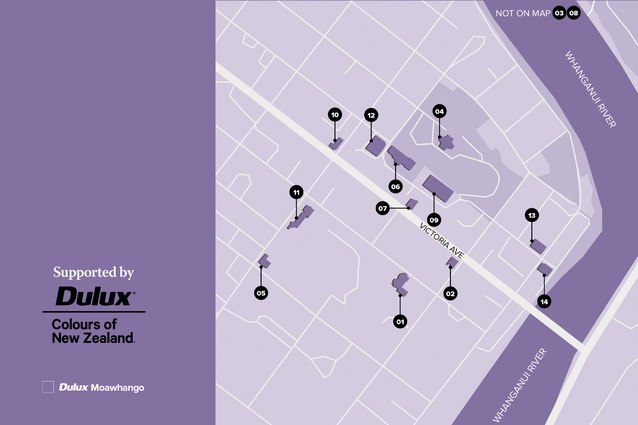Itinerary City Guide: Whanganui
In this Itinerary, supported by Dulux Colours of New Zealand, Andrew Barrie and Audrey Lam profile fourteen notable buildings in Whanganui, a city that has served as something of an incubator for architectural talent over the centuries.
Located at the mouth of the Whanganui River — the nation’s longest navigable waterway — Whanganui has long benefited from both the abundance of the coast and the commerce arising from its huge hinterland. The area is the ancestral home of Te Āti Haunui-a-Pāpārangi and Whanganui Māori tribes. Pūtiki Pā — a key site of occupation on what is now the approach to the city — remains the location of an established marae and remarkable Māori church. In 1840, Pūtiki began hosting a Church Missionary Society station. In the same year, the New Zealand Company began settling across the river from Pūtiki, its second settlement after Wellington. Disputes over land deals abounded — the Crown effectively repurchased the New Zealand Company’s block eight years later, acknowledging the deal’s flaws — and Whanganui was a key locus in the New Zealand Wars of the 1860s. The pattern of land alienation continued, with the occupation of Moutoa Gardens in the centre of the city in 1995, returning local grievances to the national spotlight.
In the city, a long period of growth from the 1840s to the late 1920s left the town with a remarkable collection of Victorian and Edwardian buildings. Progress was interrupted by the Depression but the wool boom sparked by the Korean War returned prosperity to the city. As in other centres strongly linked to agriculture (think of Christchurch, for example), this boom underwrote both innovative practices and exciting buildings. The city’s most eye-catching building, the War Memorial Hall, dates from this expansive period of civic building in the 1960s. The nation’s most remarkable example of International Style modernism and still remarkably fresh, it hovers along the edge of a civic square — so startling a vision in its provincial context, it seems the outpost of a distant civilisation.
Unlike many regional centres where key projects have been scooped up by out-of-towners, Whanganui has — likely as a result of the city’s steady prosperity — served as something of an incubator for architectural talent, generating links that spanned the nation. Born in 1850, Alfred Atkins spent time in partnership with Wellington maestro Frederick de Jersey Clere. He then formed Atkins & Bacon, and later Atkins & Mitchell, with the eventually Wellington-based practice surviving under various monikers through to the 1990s. Charles Reginald Ford practised for a decade in Whanganui before going on to join William Gummer in forming the nationally dominant firm of the 1930s and 1940s. (Gummer married into a prominent Whanganui farming family the same year the partnership formed.) Don Wilson, a gifted modernist who cut short his architectural career, was a local, as was Michael Payne, best known for his Geyser Room at EXPO ’70 in Osaka, Japan. Dickson Lonergan Architects and architect-turned-academic Mark Southcombe produced exciting work either side of the millennium.
In more recent years, an innovative local house called Dogbox was the starting point for two rising young practices now based in Wellington — Patchwork Architecture and Spacecraft Architects.
The city is still intact and thriving. After the Napier earthquake in 1931, as in many places, older buildings were shorn of seismically vulnerable stone pediments and towers, giving inner-city streetscapes a slightly clipped feeling. Big-box retail has, mercifully, remained on the periphery, demolitions have been rare, and the Main Street organisation and heritage champion Helen Craig has ensured the main street is an attractive place to spend time. The resulting urbane vibe and the availability of spacious inner-city premises have made the city a hot bed for crafts and arts. With the upcoming Sarjeant Gallery expansion set to turbocharge the cultural scene — it’s already a UNESCO City of Design — Whanganui demonstrates that ongoing architectural sophistication need not be confined to our big cities.
THE ITINERARY
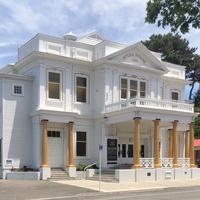
1. 1900 – Royal Whanganui Opera House
69 St Hill Street
George C Stevenson
Intended to commemorate Queen Victoria’s Jubilee, this project was initiated with a national competition. It was won by Wellington architect George Stevenson, who had worked in the Public Works Department under John Campbell, though Stevenson died, aged just 42, not long after construction began in 1899. Completed in less than a year, the building represented many innovations, including being the first municipally owned theatre in the nation and the first theatre to have electric lights, powered by a gas-fired generator located in the building. The building is classified by Heritage New Zealand Pouhere Taonga (HNZPT) as Category 1.
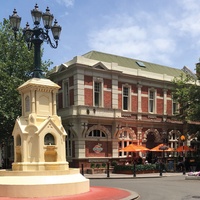
2. 1902 – Post & Telegraph Office
51 Victoria Avenue
John Campbell, Government Architect
During his term as Government Architect, Campbell designed government buildings in the Edwardian baroque style, of which this building remains the most impressive in Whanganui. Despite having its clock tower removed after the Napier earthquake, its grandeur endures. After the telephone exchange left in 1923 and a new Chief Post Office at Ridgway Street was built in 1940, the building served as government offices from 1955 to 1990. Today, only the ground-floor restaurant is accessible. Campbell fans might also check out the former Native Land Court and Aotea Māori Land Board Building (1922) at 11 Rutland Street. It’s looking unloved but a restoration project is set to begin this year.
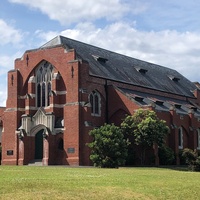
3. 1912–1919 — Whanganui Collegiate School
128–132 Liverpool Street
Various
The campus sports a unique assortment of 20th-century architectural styles. Atkins and Bacon’s buildings, including Big School (1911), showcased the red brick, stucco exteriors and tile roofs of the English domestic style. This style persisted in later additions like Charles Reginald Ford’s Cricket Pavilion (1917). Modernist contributions include the Science Block (1967) by Don Wilson and Eddie Belchambers, and the Prince Edward Auditorium (1984) by Warren and Mahoney. Dickson Elliot Lonergan’s reworking of William Gray Young’s 1912 chapel earned an NZIA National Award in 1988, and RTA Studio has added important recent projects. Refer Architecture NZ July/August 1988 and Sept/Oct 2019.
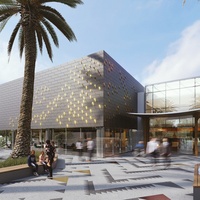
4. 1919, 2024 – Sarjeant Gallery Te Whare o Rehua
Queen’s Park, Cameron Terrace
Edmund Anscombe & Associates, Warren and Mahoney
The national competition for a new art gallery was won by Donald Hosie, a youngster articled to the Dunedin-based firm of Edmund Anscombe & Associates. Hosie was killed while fighting in France, and the project was completed by Anscombe. Hosie’s only work, it adhered to a classical style as per the competition’s brief. It also integrated the innovative ‘Top-Side-Lighted’ method of gallery illumination advocated by Christchurch architect Samuel Hurst Seager, the competition judge. The gallery is undergoing redevelopment by Warren and Mahoney, preserving the original structure while adding an extension, set to open this year. Refer NZ Architect (5) 1985.
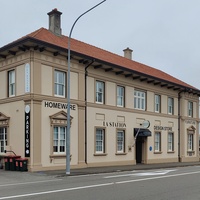
5. 1921 – Former Central Fire Station
139 Guyton Street
Ford and Talboys
This was Whanganui’s first station for a permanent fire brigade, marking a significant milestone in the development of the city’s Fire Service. The building was designed by Charles Reginald Ford, who began practice in Whanganui in 1913, while he was in partnership with Robert Talboys (1919 to 1923). The building served as the fire station until 1981, when the Fire Service moved to Maria Place, where it is still located. The exterior is still in excellent condition; the interior, which retains many heritage features, is now home to a variety of businesses.
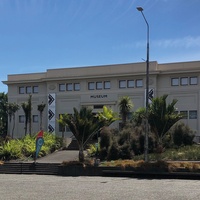
6. 1928 – Whanganui Regional Museum
Pukenamu Queen’s Park, Watt Street
R G Talboys & Associates
Talboys continued his work in Whanganui after the Ford & Talboys partnership ended. Helping to form the civic nexus of Whanganui, which includes the Sarjeant Gallery, War Memorial Hall, Alexander Library, Cenotaph and Veterans’ Steps, the Whanganui Regional Museum is a key local example of stripped classicism. This style was popular for civic buildings following the First World War, representing the return to tradition and as a symbol of stability after a period of turmoil. Dalgleish Architects received an NZIA Local Award in 2023 for its colourful Whanganui Mūmū — Whanganui By Design exhibit on the mezzanine.
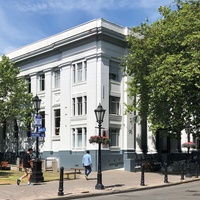
7. 1930 – National Bank of New Zealand
98 Victoria Avenue
Atkins & Mitchell
The National Bank’s previous premises, built in 1902, had been designed by Atkins & Mitchell. However, the death of Atkins in 1919 left Mitchell as the firm’s sole partner and designer of the 98 Victoria Avenue premises. With the Depression at its peak, the bank’s classical style was seen as a beacon of prosperity during difficult times. Mitchell would go on to produce the 1937 Central Fire Station in Wellington. Banking enthusiasts should also visit Crichton & McKay’s former Bank of New South Wales (1927) at 39–41 Victoria Avenue and Joshua Charlesworth’s former Bank of New Zealand (1906) at 26 Victoria Avenue.
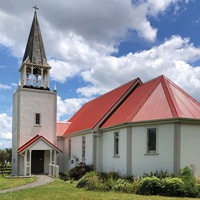
8. 1937 – St Paul’s Memorial Church
6 Te Anaua Street, Pūtiki
Arthur J Cutler
This project, testament to the long Anglican involvement at Pūtiki, was the synthesis of traditional Māori interior decoration with a relatively plain neo-Gothic architectural form that followed European patterns. Notably, the interior tukutuku panels and kōwhaiwhai, typically associated with Māori wharenui, identify the church as a Christian Māori meeting house. Sir Āpirana Ngata played a crucial role in the project: part of his effort to revive traditional Māori knowledge and expression. A hall, built in 1953, features innovative interior decoration by artist Dr Cliff Whiting. Tours can be booked at isite (see listing 14).
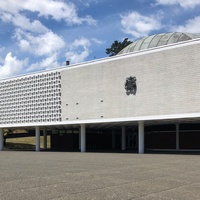
9. 1960 – War Memorial Hall
Pukenamu Queen’s Park, Watt Street
Greenhough, Smith and Newman
Opened on Anzac Day 1960, the War Memorial Hall was described by Julia Gatley as “perhaps New Zealand’s fullest, and finest, public expression of mid-century international Modernism”. The winning design of the 1956 competition, this work by young Kiwi architects resident in London, inserted the International Style into the New Zealand context, articulated in the form of a floating white box resting on slender circular pilotis. Its prismatic form contrasts starkly with the classicism of the Whanganui Regional Museum and Sarjeant Gallery. The project was awarded the NZIA Gold Medal in 1961 and an NZIA 25 Year Award in 1998.
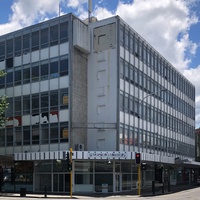
10. 1963 – Government Life Building
72–80 Guyton Street
Don Wilson, Architect
Timing is critical in architecture, and Wilson was part of the generation of young modernists whose careers were boosted by the post-war building boom. He studied in the 1950s as a Fulbright Scholar at the Illinois Institute of Technology during Mies van der Rohe’s tenure there. Standing on a prominent corner site, the Government Life Building was initially designed in 1957, and Wilson arranged his scholarship to study then-current construction methods. Returning to Whanganui, Wilson completed the technically adventurous project, which includes a particularly innovative curtain wall design. Mark Southcombe’s article on Don Wilson, available online, is worth seeking out.
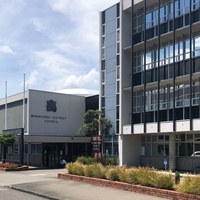
11. 1968 – Whanganui City Council Buildings
101 Guyton Street
Wilson, Belchambers, Low & Associates
Eddie Belchambers, the project architect for this building, had entered Wilson’s firm in the 1950s as an assistant. His scheme placed the low-rise Council Chamber — intended to relate to the War Memorial Hall — on the corner, with administrative offices in a four-storey slab running along the street. Still in excellent condition, the project received an NZIA Local Enduring Award in 2004. Exasperated with the difficulties of architectural practice, Wilson changed career in 1970, but fans might also check out his additions to the Whanganui Regional Museum (see listing 6), completed in 1968. The firm continued successfully into the 1980s.
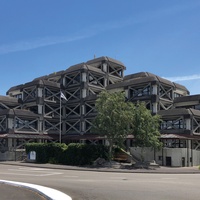
12. 1981 – Whanganui Departmental Building
133 Wicksteed Street
Ministry of Works and Development
Produced by Ministry of Works and Development project architect Tony Baker under Government Architect Graydon Miskimmin, this project sets aside the tower form typical of government buildings in favour of the terraced form. This human-scaled building was intended to sit more comfortably in its low-density context and to loosen up the institutional working environment. Planting on the terraces, which has come and gone over time, helped with this softening. However, the combination of exposed cross braces — an innovative structural solution which opened up internal planning — and heavy roofs ultimately made it one of the toughest expressions of brutalism in Aotearoa New Zealand.
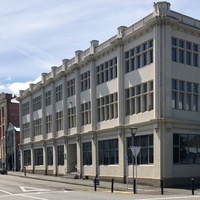
13. 2008 – Henry D Bennett Building
28 Taupo Quay
Designgroup Stapleton Elliott and Dickson Lonergan Architects
Built in 1926 by Christchurch-based architects Sidney and Alfred Luttrell, this is one of the largest buildings in Whanganui. Now occupied by UCOL Whanganui, the renovation project earned its architects an NZIA Local Award in 2009. The jury wrote: “A sensitive re-working/recycling has injected new life into this heritage building. Modern services have been incorporated while the historic features of the training institute’s external skin and simple, honest structure have been carefully maintained and upgraded. Structural strengthening, new accessible ramps, internal detailing and the enhancement of the Art Deco façade have been executed by a skilled, caring architect.”

14. 2009 – Whanganui isite
31 Taupo Quay
VOID Architecture Research Urbanism
Standing on the riverfront not far from the Town Wharf, this building was originally completed in 1895 as a warehouse for James Thain & Co., an important regional import company specialising in ironmongery and hardware. The firm would later develop a large new building — by local architect Thomas James — on a very prominent site at the end of the Victoria Avenue Bridge. This was recently demolished following a fire. Mark Southcombe executed a sympathetic adaptation of Thain’s Warehouse in 2009, involving the insertion of a café, gallery and isite visitor information centre, earning an NZIA Local Award in 2011.
Other addresses
1891 – Fire Watchtower
Cooks Gardens, 99 St Hill Street
Alfred Atkins
1913 – St Paul’s Presbyterian Church
112 Guyton Street
William Gray Young
An early solo work by the eminent Wellington architect.
1930 – Ladies’ Rest
75 St Hill Street
Thomas Battle
1933 – Alexander Heritage & Research Library – Te Rerenga Mai o Te Kāuru
Pukenamu Queen’s Park, 1 Pukenamu Drive
Hood & Duffell
Strengthened and restored by Bruce Dickson in recent years.
1940 – Former Chief Post Office
60 Ridgway Street
R G Talboys & Associates
Notable for stripped classical decoration that includes Māori motifs.
1957 – Former Power Board Offices
151 St Hill Street
Clifford Newton Hood with Francis Willis
1975 – Wairere House
1 Bates Street
Works Consultancy
In 1982, when this building was infamous as the Wanganui Computer Centre, anarchist Neil Roberts blew himself up outside in protest at the police’s ‘Big Brother’ system.
1975–2003 – Quaker Settlement
76 Virginia Road
Michael Payne
Parts of the complex can be booked for events or accommodation.
SOURCES
For a general history of Whanganui, we suggest Maxwell Smart and Arthur Bates’ The Wanganui Story (Whanganui: Wanganui Newspapers, 1973). Some key historical buildings in the area are included in Historic Buildings of New Zealand: North Island (Auckland: Cassell, 1979). Many of the more recent projects in this guide are included in Julia Gatley’s Long Live the Modern (Auckland: Auckland University Press, 2008), and several feature in Peter Shaw’s New Zealand Architecture: From Polynesian Beginnings to 1990 (Auckland: Hodder & Stoughton, 1991). Mark Southcombe, a formerly Whanganui-based architect now teaching at Victoria University of Wellington, has written extensively on Whanganui’s architectural history; much of his writing is now available online.

The Itinerary series is supported by Dulux Colours of New Zealand. Dulux Colour Specialist Davina Harper has selected a Colours of New Zealand palette based on this itinerary. See the full range and order colour samples here.



